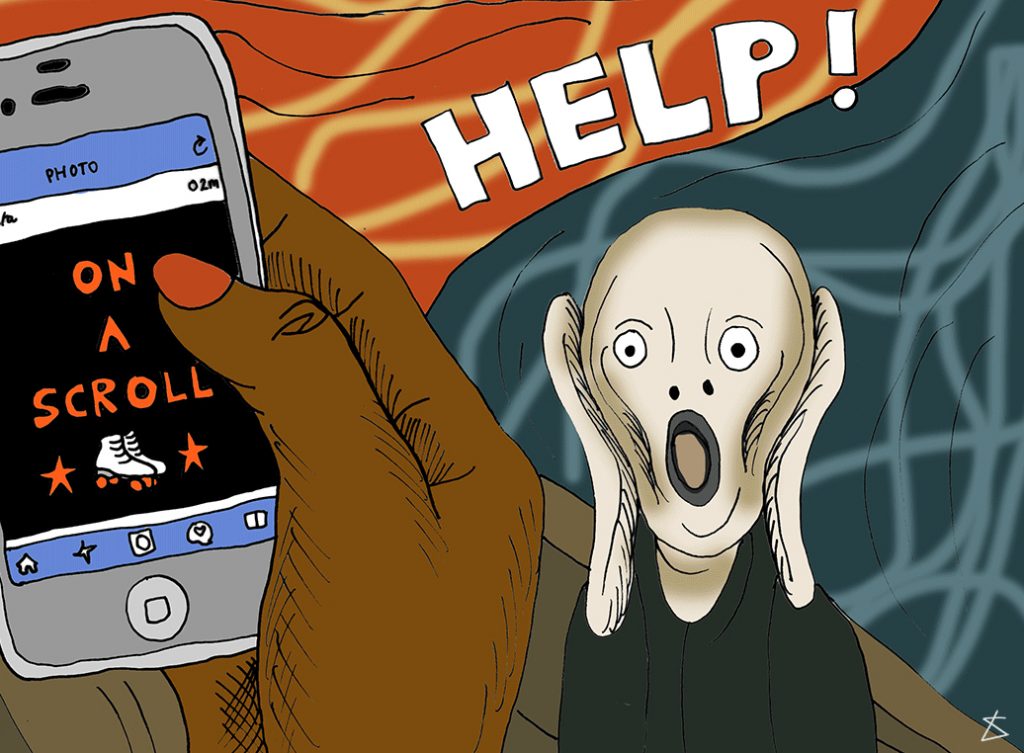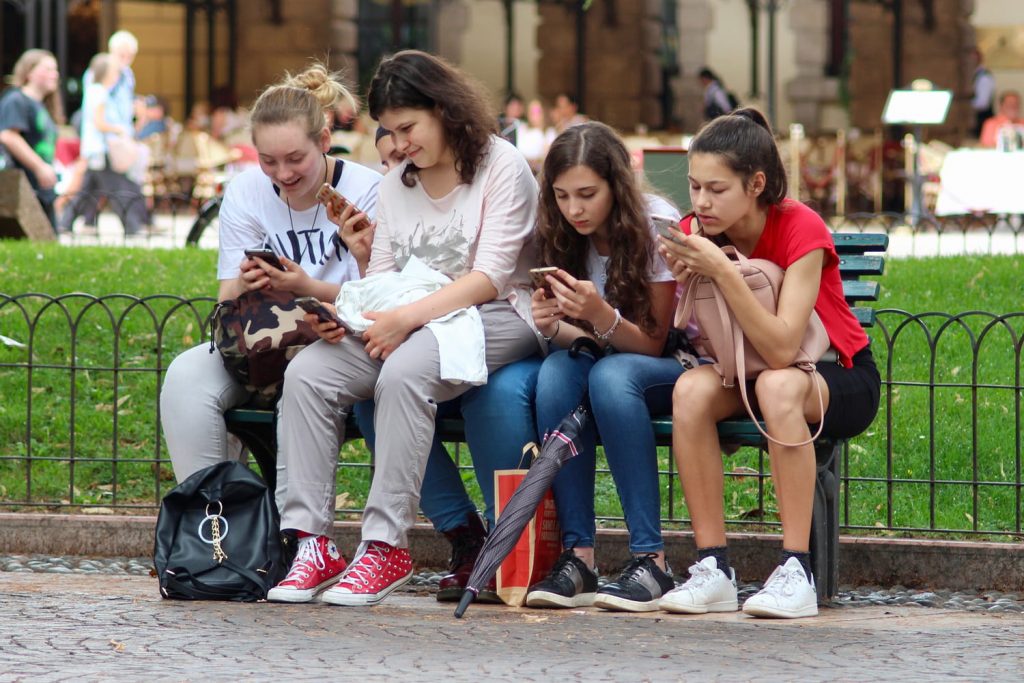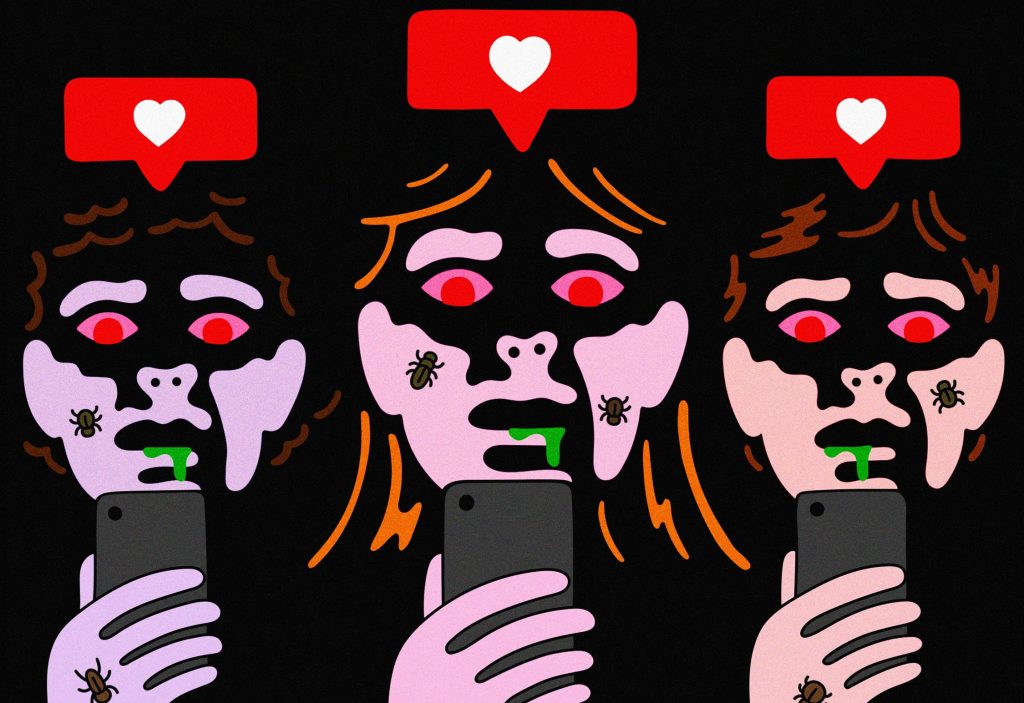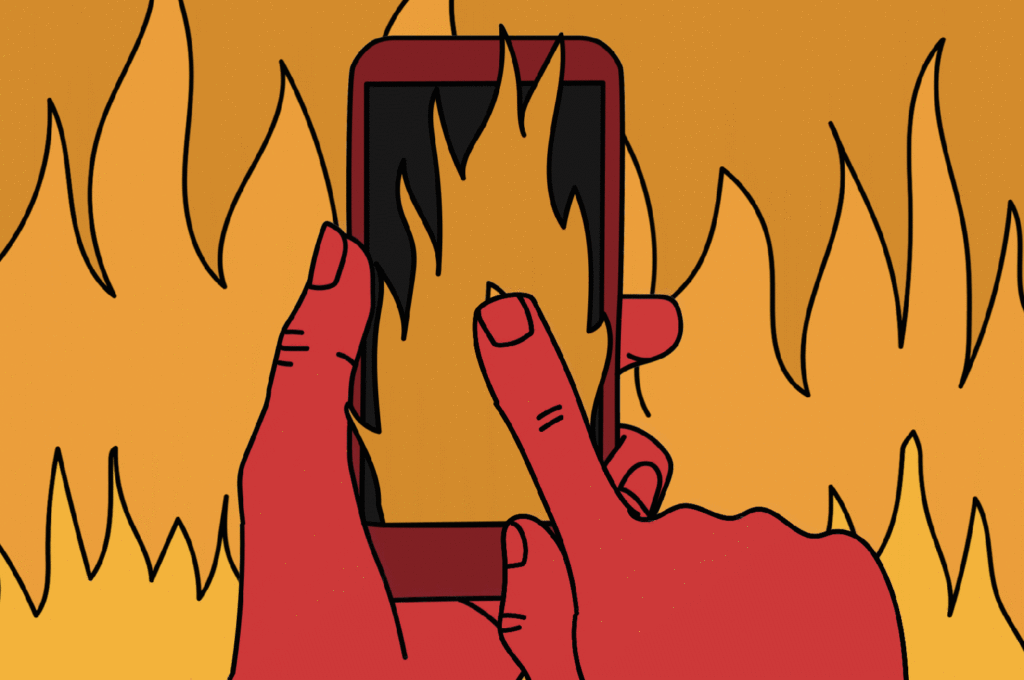A potential U.S. ban on TikTok, recently signed into law by Congress, is only one of the latest controversies surrounding the video platform. Long-needed regulations for the app are finally being implemented over legislators’ concerns that its Chinese parent company, ByteDance, poses security threats through access to American data.
The debate is heightened by the app’s extraordinary ability to generate profit. YouTube Shorts, Instagram & Facebook Reels, Amazon Shop, Snapchat, and more have all co-opted the short-form video format as a surefire way to keep consumer attention. A glance around in public today is often peppered with people scrolling away at short-form content, captivated by its endless supply.
So what’s really at risk with TikTok? National security, maybe—but more glaringly, what short-form media is doing to all of us.
The State of Screens
Today, the average American spends seven hours a day staring at a screen. Eighty-eight percent of them use “second screens” while watching TV. More than one billion individuals were registered to TikTok as of April 2023, 116.5 million of whom are in the United States—more than a third of the country’s entire population. In 2021, TikTok was visited more frequently than Google.
There are many supposed “positives” to the platform: user-controlled media provides culturally relevant content, connecting millions of people across the globe. Gone is the height of long-form YouTube fame—today, countless articles suggest ways to make more “snackable” content to advance brand platforms.
Widespread smartphone use has only become common within the previous generation, and its effects on cognition have yet to be realized in their entirety. In the meantime, we may be unintentionally re-wiring our brains, and not for the better.
Studies show that short-form video interaction creates positive feelings, but is also used to mitigate negative feelings or prolong procrastination—practices that lead directly to addiction. Without the videos, users experience legitimate feelings of withdrawal.
How strong is this addiction? Researchers conclude that TikTok’s ultra-friendly UX is “aimed to keep users in an extremely passive state”: one low-effort swipe is all it takes to unconsciously turn ten minutes of scrolling into an hour. New “scrolling rings” make the mindless time-suck easier than ever—“TikTok while taking a bath, TikTok while walking on a treadmill, TikTok while making dinner,” writes one review. We’ve all been “phubbed” at least once by a TikTok user.
Social media apps function like slot machines, refreshing feeds in “variable patterns of reward,” engaging users under the idea that “the next play might be ‘the one’”. One study remarks the incredible resemblance of social media apps to gambling, a striking comparison when considering that “gambling is the only behavioral addiction” officially recognized by the American Psychiatric Association and the DSM-5.
The brain does not discriminate between types of addiction. Continued use of short-form media effectively reduces us to video addicts. They’re the ultimate form of instant gratification and are proven to shorten your attention span. Habitual users can slowly lose the ability to focus and have decreased engagement with the present moment.
Short-form video apps enable users to “develop interpersonal attachment” to a platform and make us “functionally dependent” on their use. Video media is filled with novelties that acclimate the brain to an environment of constant change. In the less-stimulating real world, it can be challenging to adapt to a slower pace, creating impatience in interpersonal relationships and daily life. Board game classics like Scrabble and Monopoly are now being simplified due to a “growing preference for games that offer fast-paced and easily digestible experiences from younger audiences accustomed to scrolling through short videos”.
TikTok’s algorithms are so advanced that the app can use data mining, down to the user’s login method or even sexual orientation, to predict what might “meet their appetite”. It’s not the content itself that’s addictive, it’s the system design: the “infinite scroll” tricks the brain into thinking it’s being highly productive.
To make matters worse, TikTok, Instagram, and Facebook have reconfigured their feeds to show posts based on user preferences, instead of chronologically. We are now more likely to see posts from total strangers than our actual friends—if we’re using social media in an effort to stay “connected”, this doesn’t look like the way to do it.

Minors Online
Gen-Z in particular has been raised in the “ultra-distractible” world. A 2021 study showed that youth use social media to relieve “perceived stress”. If we are so stressed, aren’t we better off logging out?
In response to allegations about its risks for minors, TikTok spokesman Alex Haurek claims that TikTok employs “industry-leading safeguards for young people”, like parental controls or prompts to log off after an hour. These tools are not exactly cutting-edge measures. The Chinese version of TikTok, Douyin, has much stricter regulations for underage users. Zeyi Yang from MIT Technology Review writes that discrepancies between Douyin and TikTok are not “some sort of conspiracy”—Yang believes the two platforms would likely be very similar “were it not for how quickly and forcefully” China regulates digital platforms.
China is infamous for its incredibly strict censorship laws and suppression of free speech, and the idea that TikTok “disrupts social harmony” has mostly been perpetuated by governments looking to suppress free speech and limit media freedoms. However, it remains true that the ability to exercise regulation with regard to the protection of minors is essential in mitigating media dangers. And to make things clear, it’s not just minors who are addicted.
In the United States, however, teens average 103 minutes a day on TikTok. Around 2 in 3 American teens use TikTok, and of those, 1 in 6 say they are on the app “almost constantly”. Brown University and Common Sense Media report that sixty-eight percent of young girls with depressive symptoms on TikTok feel addicted to it. On average, the female adolescent age group logs over two and a half hours per day.
These girls who constantly used social media were also more likely to say their lives “would be better” off without it. Almost 1 in 4 girls reported TikTok interfering with their daily sleep. Over thirty percent of TikTok and Instagram users experience poor body image weekly. Recently, a middle school in North Carolina removed the mirrors from its bathrooms to prevent students from making TikToks during class.
Dozens of lawsuits have been filed in the United States against Meta and TikTok amid claims by parents that these apps have caused harm to their children, as well as new suits in Utah, the EU, and New York City on the basis of addictive platform design.
Current laws have been highly effective in protecting social media companies from legal suits: Bloomberg writes that companies “cite their constitutional free-speech rights as publishers to control their content… it’ll be difficult to prove that social media use alone is to blame for health issues in today’s “complex society,” in which kids are exposed to all kinds of influences.”
Still, ninety-eight percent of teenage girls use social media, and seventy-three percent use TikTok, sparking questions about its effects on the next generation. Media literacy is critically lacking in Gen-Z—“digital natives” have turned out to not be so savvy after all, and are even three times more likely to fall for online scams than older generations. California’s Assembly Bill 873 will now require media literacy curriculum in K-12 classrooms as an extension to previously optional guidelines. New Jersey, Delaware, and Texas have already adopted bills requiring similar mandatory instruction.

Content for Consumption
TikTok’s educational value is limited. While many users claim they “learn a lot” from the app, the brevity of its content often lacks contextual depth or is even falsified. Learning through a superficial understanding of content online may impact our ability to challenge ourselves with real depth. Most short-form media uses “humor, shock value, and sensationalism” to engage the user—good for a dopamine rush, but any information learned is unlikely to be retained due to high volume and poor quality.
Even news junkies are rarely recommended legitimate news sources on the app. Now Gen-Z is taking misleading advice about the stock market on TikTok, from a pool of content creators where less than 1% have any financial credentials.
TikTok has also come under fire for its “micro-trends” that feed the fast-fashion industry, exacerbating global crises related to the unsustainable production of cheap goods. While buyers can’t be held accountable for the pitfalls of supply chain capitalism, it is evident that short-form video cycles are playing into larger patterns of short-lived fashion fads—and convincing us to buy things we don’t need.
Wall Street Journal posits that TikTok Shop is on a “collision course” with Amazon, with researchers estimating e-commerce on social platforms will grow into a $100 billion market by 2025. Both this consumer boom and the influencer economy are likely the results of an increasingly unaffordable world, where low-quality virtual pleasures stand in for overpriced real-world experiences. Facing a future filled with unpredictable inflation, housing instability, and Zoom work meetings, what teen wouldn’t want to become an overnight “influencer”?
A Post-Covid Media Era
When the pandemic struck full force, millions of people across the globe turned to TikTok as a distraction from collective quarantine boredom. The generations to whom we trust the next decades of civic progress have now grown up operating through lenses skewed by the trauma of our times and ultimately shaped by our “chronically online” lifestyle.
Younger users lack the self-discipline necessary to regulate their time on social media platforms; they feel “obliged to engage” with peers online to be accepted, and are targeted by algorithms to stay hooked. They have become cogs in the wheel of an “attention economy” where the media fights for profitable consumer engagement. The youth and their data are a commodity—and for companies to be successful, they must manufacture habituation and dependence.
An entire generation at a highly impressionable age has had their social norms, perceptions, and behaviors formed by years spent online. Anahi Pellathy at the Standard puts it best, writing that “social media limits individuality by allowing nearly everyone access to a shared drive of background knowledge… In this way, everyone starts to act the same… The individual disappears into the collective.”
In a world of automation and virtual reality, “real, live” stuff has become a novelty— books, concerts, shopping, even going to class. We have begun to abandon the practice of sustained focus in favor of simultaneous screens, abbreviated content, and the next best thing just ahead during our doomscroll. As a result, our real-world environments suffer: we waste hours a day watching poorly produced content we will soon forget, students can’t pay attention in school, and friends are unable to give each other the same quality of face-to-face interaction they deserve.
There’s an illusion of effortlessness that arrives as media is getting shorter, more rapidly and easily consumable at volume. So, what’s a good compromise? How do we stop helicopter governments from managing our every digital move while simultaneously curbing the consequences of social internet addiction?
We cannot ban TikTok. Its social influence, revenue potential, and existing user base make democratic legislation on the issue increasingly difficult to orchestrate. In a statement on political candidates, TikTok itself declared that if we are “truly concerned about protecting data, a better approach is a national privacy law that applies to all technology companies equally.” It looks like they’re right. If national security is so threatened by a video app, then maybe the bigger problem is with our security standards.
We can’t be sure what kind of data China would have through TikTok; top defense officials aren’t exactly posting nuclear war codes on the app. In Montana, District Judge Donald Molloy ripped into Solicitor General Christian Corrigan over the state’s ban on the app, arguing that “everybody on TikTok voluntarily gives their personal data”—but who’s really reading the terms and conditions?
Meta’s global head of safety says the issue requires a “comprehensive approach” to deal with problems on a variety of platforms. While the company continues to feed the public lip service in lieu of real solutions, millions of users remain highly addicted to its revenue source.
Companies like Google and Instagram once sought to proliferate democratic information or help maintain friendships through picture-sharing. Today, they have devolved into profit-hungry conglomerates monopolizing our attention. We fall into distraction from our real responsibilities by escaping to the digital “metaverse”, whose attraction may soon prove to be too strong to remove ourselves from. Even Pope Francis wrote in 2015 that “the technological paradigm has become so dominant that it would be difficult to do without its resources, and even more difficult to utilize them without being dominated by their internal logic”.

Where do we go from here?
The modern American is obsessed with a need to think with more speed, efficiency, and complexity than our predecessors and peers. The environments created by information technologies are ripe for consumption, encouraging us to use and develop platforms that increase knowledge digestion. Technology is useful for a number of tasks that require cognitive offloading, automating dangerous processes, or saving lives. But what happens when it all becomes too much, too soon?
Assuming humans still have the capacity for self-control, it will take a lot of smartly crafted regulatory legislation for the digital information environment to become less destructive. Computer scientists, engineers, sociologists, information technicians, and others with knowledge of how and why social networking systems function will need to step forward with actual policy solutions. We have to ask ourselves: What are we creating? What do we think we are creating?
Video sharing is a plausible way to access new ideas, connect with peers, and laugh with your mom at silly dog videos. Obsessive consumption of short-form media content is a different story. Kate Lindsay at The Guardian observes how hard it will be to wean ourselves off of short-form video, especially when “over one billion people are hanging out somewhere else…. little remains of what made people join social media in the first place. TikTok may have won the social media war, but it left wreckage in its wake.”
There’s an age-old adage in marketing: “If you’re not paying for it, you’re the product”. When business lacks readily available physical space to capitalize, they turn to exploit the space in our minds. We can no longer allow ourselves to be victims of the attention economy, pawns in a game most users don’t even know they’re playing.
Let’s be honest: short-form media is mindless, and if we’re not careful, we will be too.
Featured Image Source: EMMA KUMER/RD.COM






Comments are closed.